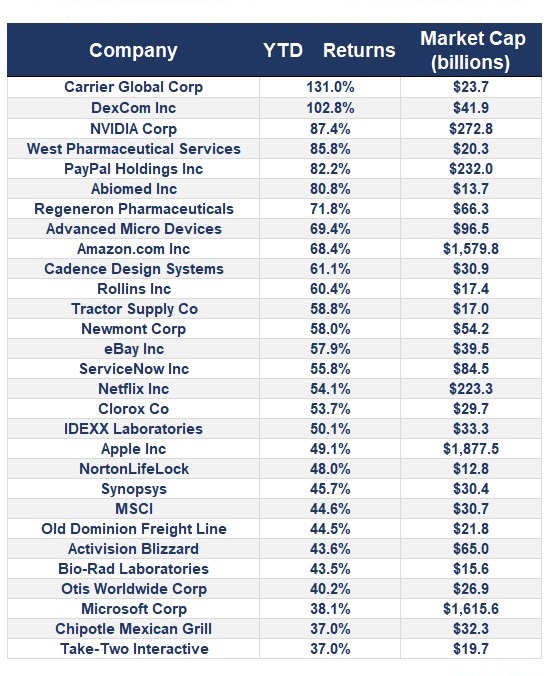Lying with numbers is easier than with words. Why? People equate math with science and science with fact.
The S&P 500 isn’t lying to us. In fact all statistics below are accurate. We aren’t being lied to but we sure are being misled.
Here’s an interesting chart put together by Goldman Sachs:
YTD the largest five stocks collectively returned 35%, the remaining 495 stocks lost 5% and the index as a whole is up 2%. What gives?
Welcome to the world of cap-weighted indexes.
Apple’s (“AAPL”) market cap is closing in on $2 trillion. Microsoft (“MSFT”), Amazon (“AMZN”) and Google parent Alphabet (“GOOGL”) all have market caps over $1 trillion. The 5th largest stock in the S&P 500 (Facebook – “FB”) has a market cap of about $800 million. The larger the company the greater the impact on the level of the index.
Let’s look at more interesting numbers. Here are the thirty best performing S&P 500 stocks YTD along with their market cap:
Some rather eye-popping returns. Indexers and cost-conscious investors ought to be ashamed of themselves settling for the S&P’s 2% return when they could have earned such amazing returns on a number of individual stocks. (Ironically Big Media and financial “experts” keep beating into our heads that active management is expensive and can’t beat indexes so we should all pile into index funds and index ETFs.)
Finally let’s look at a distribution of returns of the 500 stocks in the index:
As of yesterday’s close there are 142 stocks up 10%+. Similarly there are 220 stocks down 10%+.
What’s it all mean?
When investors use cap-weighted strategies they are concentrating in a handful of names. In years like 2020 when the largest five stocks are really really really large they pull the index level higher despite the returns of the rest. Cap weighting works in both ways. A selloff in these five names would pull the level of the index much lower relative to the performance of the 495 other stocks in the index.
Are you sure you’re diversified by investing in an index fund or ETF?



Leave A Comment